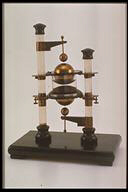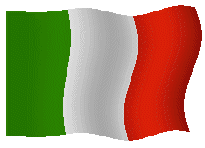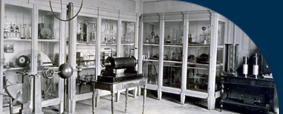
 |
Righi's three sparks oscillator |
 |
Oscillatore a tre scintille di Righi |
| Subject: electromagnetism/ generator of centimetrical electromagnetic waves |
Settore: elettromagnetismo/generatore di onde elettromagnetiche centimetriche |
| Number of catalogue: 40 |
Numero di inventario: 40 |
| Unsigned |
Non firmato |
| c. 1900 |
Periodo di costruzione: 1900 circa |
| Mahogany, brass, plastic material, ebonite, paraffin oil |
Materiali utilizzati: Mogano, ottone, materiale plastico, ebanite, vasellina |
| 375 X 220 X 470 [mm] |
Dimensioni: 375 x 220 x 470 [mm] |
| |
|
The origin of this instrument is linked directly to the experimental verification of the electromagnetic theory of light synthesized by the famous Scottish physicist J. C. Maxwell (1831-1879). The first experimental verification of this theory was made by the German physicist Henrich Hertz (1857-1894) who used an oscillator and a resonator to verify in a series of experiments (1886-1889) that the electric waves reflected, refracted and interfered just as beams of light do. In his verification Hertz used mirrors, lenses, and prisms of very encumbering dimensions and also an (air) oscillator with metal spheres that was able to produce a wave with a minimum length of 66 cm. A more accurate verification of Maxwell's hypothesis was given only in 1893 by the physicist Augusto Righi of Bologna (1850-1920) thanks to changes and improvements he had made to the instruments used. In particular, in order to reduce the wave length produced by Hertz's oscillator and to reduce the size of the optical apparati needed to prove the theory, he projected a new oscillator, or a spark gap with three sparks, to reduce the capacity and the self-induction. The oscillator consisted of two central metal spheres that emerged into a container filled with paraffin oil, through which the oscillatory discharge was produced. The idea was not new (Righi himself had mentioned the previous attempts by the Geneva physicists De la Rive and Sarasin). However, it quickly led the physicist from Bologna to work with wave lengths of about 10 cm until he produced microwaves that were 26 mm long and until he proved the complete analogy between the "electric waves" and the radiations of light and heat. |
L'origine di tale strumento è direttamente legata alla verifica sperimentale della teoria elettromagnetica della luce sintetizzata dal noto fisico scozzese J. C. Maxwell (1831-1879). La prima verifica sperimentale di tale teoria si deve al fisico tedesco Henrich Hertz (1857-1894) che utilizzando un proprio oscillatore ed un risuonatore verificò in una serie di esperienze (1886-1889) che le onde elettriche si riflettevano, si rifrangevano ed interferivano come i raggi luminosi. Nella sua verifica Hertz si era servito di specchi, lenti e prismi di ingombranti dimensioni nonchè di un oscillatore (ad aria) a sfere metalliche che era in grado di produrre una lunghezza d'onda minima di 66 cm. Una verifica più accurata dell'ipotesi maxwelliana fu data solo nel 1893 da parte del fisico bolognese Augusto Righi (1850-1920) grazie a modifiche e perfezionamenti da lui stesso apportati nella strumentazione usata. In particolare, al fine di ridurre la lunghezza d'onda generata dall'oscillatore hertziano e con essa gli apparati ottici necessari alla verifica della teoria, egli ideò un nuovo oscillatore, ossia un spinterometro a tre scintille, in cui, per ridurre la capacità e l'autoinduzione, le due sfere centrali metalliche erano immerse in un recipiente pieno di olio di vasellina attraverso il quale si produceva la scarica oscillatoria. L'idea anche se non nuova (lo stesso Righi cita i tentativi precedenti dei fisici ginevrini De la Rive e Sarasin) portò rapidamente il fisico bolognese a lavorare con lunghezze d'onde di circa 10 cm fino a produrre microonde di 26 mm ed a dimostrare la completa analogia tra le "onde elettriche" e le radiazioni luminose e termiche. |
| |
|
Description: Two columns of plastic material upon a black, painted, mahogany base vertically support the oscillating system through brass screw rings. Unlike Hertz's oscillator, which used the oscillation of only one electromagnetic discharge in the air, Righi's oscillator consists of a system with three sparks, and the oscillating discharge does not take place in the air. The oscillator consists of four metal spheres, which are insulated from each other: the larger ones, each emerged halfway in paraffin oil, are in the centre and the smaller ones are at the extremities. |
Descrizione: su una base in mogano verniciato in nero due colonne di materiale plastico sostengono verticalmente, tramite ghiere a viti d'ottone, il sistema oscillante. Questo, a differenza dell'oscillatore di Hertz che utilizza le oscillazioni di una sola scarica in aria, è un sistema a tre scintille e la scarica oscillante non avviene in aria. L'oscillatore è composto da quattro sfere d'ottone, tra loro isolate: due più grandi al centro, per metà immerse in olio di vasellina, due più piccole alle estremità. |
| |
|
Function: By connecting the smaller spheres to the secondary circuit of a Ruhmkorff coil, the system starts oscillating: the interruption of the discharge in the paraffin oil electromagnetically induces an attenuated discharge in the opposite direction. Every opening and closing of the coil's switch, therefore, generates a new series of dampened oscillations. The oscillations are generated only in the case of an instantaneous discharge. The surface of the sphere must therefore be smooth to avoid leakages due to roughness. The immersion into the paraffin oil favours the production of an instantaneous discharge, a more uniform emission of electricity, and hampers the deterioration of the surfaces of the spheres caused by the sparks (in the case of Hertz's oscillator the surface must be frequently cleaned). |
Funzionamento: collegando queste ultime al circuito secondario di un rocchetto di Ruhmkorff, il sistema entra in oscillazione: l'interrompersi della scarica nella vasellina induce elettromagneticamente una scarica attenuata in direzione opposta. Ogni apertura o chiusura dell'interruttore del rocchetto, quindi, genera una nuova serie di oscillazioni smorzate. Le oscillazioni si generano solo nel caso di una scarica istantanea. La superficie della sfera deve essere quindi ben levigata per evitare dispersioni dalle rugosità. L'immersione nell'olio di vasellina favorisce l'istantaneità della scarica, una più uniforme irradiazione di energia ed impedisce il degrado delle superfici delle sfere (nel caso dell'oscillatore di Hertz la superficie deve essere frequentemente ripulita). |
| |
|
Bibliography: Bernardini, Mantovani, Vetrano [1987], pp. 129-131; Mantovani [1994], p. 69. |
Bibliografia: Bernardini, Mantovani, Vetrano [1987], pp. 129-131; Mantovani [1994], p. 69. |
|
|

